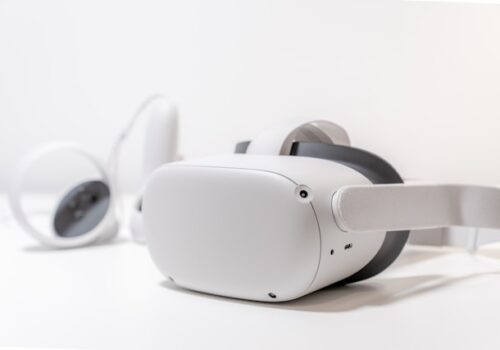The Growing Excitement Around VR and AR Headsets
The frenzy around VR and AR headsets has been real over the last few years. Now, not as an exclusive trade, big tech companies including Apple, Google, and Meta are striving to dominate this field.
What Makes VR and AR So Exciting?
Both VR and AR are part of ER (Extended Reality), which takes in users of all ages. Simply put, through virtual reality, one finds themselves fully submerged in a digital environment, while augmented reality involves adding computer-generated effects on top of what one sees using their physical eyes.
For example, you can think of Ralph Miles – a retiree who bought the Quest 2 headset just to stay active and be with his grandchildren through it.
Key Players in the VR and AR Market
Tech giants are sprinting towards developing the best possible virtual reality (VR) & augmented reality (AR) goggles. Below is a closer look at the participants involved as well as what they offer:
- Meta: Meta, previously known as Facebook, controls the Virtual Reality market with its bestselling Quest 2 headset. They also have another headset under development, Cambria, designed for enhancing VR technology.
- Apple: Apple is expected to release an AR headset, which is rumoured to set new industry benchmarks with its advanced features.
- Google: Google is returning to the market of augmented reality with its Iris project, after Google Glass.
- Microsoft: Still, Microsoft’s HoloLens 2 is a dominant player in AR, especially for business applications.
Other notable companies are ByteDance, which owns Pico, a VR headset maker, and Sony, which is known for PlayStation VR. IDC predicts that 16 million headsets will be shipped this year, indicating increasing interest and investment in VR and AR.
Current Uses and Potential Markets for VR and AR
While gaming has been the primary use for virtual reality, there are many other potential markets for both virtual reality (VR) and augmented reality (AR) technologies. Explore these possibilities:
- Gaming: With VR, gaming will never be the same again; it allows players to immerse themselves in alternative realities and environments.
- Education: From virtual field trips to immersive simulations, VR and AR provide interactive learning experiences that engage learners.
- Healthcare: These technologies have found their applications in medical practices, comprising patient education and treatment as well as enhancing care quality
- Business: Remote work can become more efficient if virtual meetings, training or collaborative workspaces are facilitated by using VR or AR.
IDC’s prediction of 16 million headsets being shipped this year and future sales potential highlight the need to be the dominant platform, much like smartphones during their early days.
Challenges and Innovations in AR Technology
However, AR technology has its own unique challenges and is expected to undergo some breakthroughs.
- Snap’s Spectacles: They are designed to bring AR into everyday life by overlaying digital information on top of actual reality via a wearable device.
- Microsoft’s HoloLens 2: Mainly used in enterprise environments, HoloLens 2 comes with advanced AR capabilities for training, maintenance as well as collaboration projects.
AR nevertheless faces problems such as high costs and low performance.
Looking Ahead: The Future of VR and AR
The future of VR and AR headsets looks quite bright, with potential uses beyond gaming. Here is what we can expect in the years to come:
- Tony Fadell’s Comparison: Tony Fadell – the guy behind iPods and Nest thermostats–sees a future where our headsets will be as important as our smartwatches.
- The evolutionary process of computing: VR and AR, the next stage of computer technology, have brought new forms of relating to digital content and reality.
- The Wearable Technology Ecosystem: Complementing other wearables such as rings and glasses, among others, offers diverse experiences.
Beyond Gaming: Applications of VR and AR in the Real World
VR and AR are on the verge of transforming various aspects of our everyday lives. Let us look at some real-life applications of these technologies:
- Education-Virtual classrooms and textbooks enhanced by AR.
- Healthcare-VR for pain management and surgical guidance through AR.
- Business-Virtual prototyping; AR-based remote assistance.
Comparing VR and AR: Strengths vs Weaknesses
| Aspect | VR | AR |
| User Experience | Fully immersive, separate from reality | Overlays digital content onto the real world |
| Cost | Generally higher due to immersive hardware | AR glasses can be more affordable |
| Application Scope | Primarily gaming, education, and training | Broad, including navigation, shopping, and more |
| Market Presence | Growing rapidly, driven by gaming | Expanding in enterprise and consumer markets |
- Experience of Users: Unlike VR, AR adds to reality in a way that can be described as fully immersive.
- VR Costs: However, because of their hardware requirements, VR headsets are generally more expensive compared to AR devices, which have a wide price range.
- Application scope: On the other hand, VR is more focused towards entertainment and training, while AR has wider fields of application.
- Market Presence: Though still expanding, for example, VR technology is making remarkable strides in gaming while AR is finding a niche in diverse industries.
Embracing the VR and AR Revolution
Looking into the future, these two technologies will revolutionize our experiences. By embracing this development, it would be possible to create new realities across multiple sectors.





